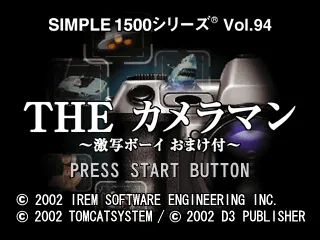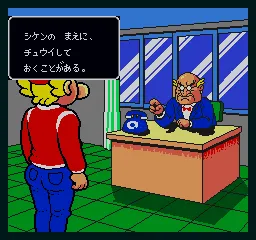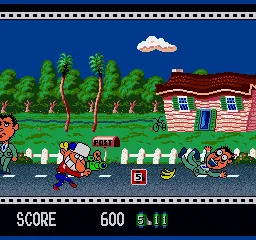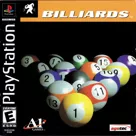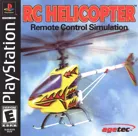Gekisha Boy
Description
Gekisha Boy is a 2D side-scrolling game in which you play the part as a camera man who is out to snap some high paying photos to please their contractor. You control the movement of the shutter aim and you have slight control over the character as well (using the same style of control as such games as Cabal). You walk along a side-scrolling street and you have to snap unusual/tragic/funny or simply weird photos to rack up the points. It can be anything from crashing airplanes to Marilyn Monroe lookalikes and UFOs abducting cars. Every stage has a set score you need to reach to progress to the next one or you have to start it over again.
The PlayStation version The Cameraman: Gekisha Boy Omakefu is an updated and expanded port released as Volume 94 of the Simple 1500 series and contains an additional stage. It also has an unlockable cooperative mode with a second player as the Gekisha Girl. Otherwise the versions are identical in graphics, sound and gameplay.
Spellings
- THE カメラマン~激写ボーイ おまけ付~ SIMPLE1500シリーズ Vol.94 - Japanese PlayStation spelling
- 激写ボーイ - Japanese TurboGrafx-16 spelling
Groups +
Screenshots
Credits (TurboGrafx-16 version)
12 People
| The people who came up with the game (ゲーム を かんがえたひと) |
|
| The people who programmed (プログラム したひと) |
|
| The people who drew the art (え を けいたひと) |
|
| The person who created the music (おんがく を つくったひと) |
|
| The people who gave advice (アドバイス したひと) |
|
| The people who produced (プロデュース したひと) |
|
| Presented by |
|
Reviews
Critics
Average score: 79% (based on 4 ratings)
Players
Average score: 3.2 out of 5 (based on 2 ratings with 1 reviews)
Is that your zoom lens or are you just glad to see me?
The Good
When I was a kid, I used to watch a comedy show called “Hey Hey It’s Saturday” and looked forward to a segment known as ‘Phunny Fotos’ where viewers would send in photos taken of strange things. The winner was not determined by the host, but by the studio audience. It was years later that I discovered an unusual game from Irem that shared a similar concept. Gekibo: Gekisha Boy (激写ボーイ) was only released in Japan, meaning Westerners were unable to play the game unless they imported it. Even if the game was imported, anyone who was not fluent in Japanese could not understand what they needed to do. Thank God someone released a translation of the game in 2002, otherwise I would be lost.
David Goldman, an ordinary citizen who enjoys taking pictures, enrols at L.A. photography school, hoping that he can improve his skills. Things were looking up for him until he finds out that his parents were killed in a plane crash. Too depressed to continue studying, he was on the verge of dropping out. The dean realizes what happened and offers to graduate him if he manages to get him eight photos, which range from a flying car to a shoot-out in the Wild West.
The story is presented in series of negatives, accompanied by some amusing pictures. When I viewed the second picture, I wondered why there was Japanese writing on top of a building located in the United States. Then there is a picture showing Goldman on a commuter train, jammed in-between two women with their breasts pressed against his face. It reminds me of the front cover for Leisure Suit Larry: Magna Cum Laude.
In eight horizontally-scrolling scenes (referred by the game as "takes"), you move a shutter aim around the screen with the directional keypad. If the aim hovers over anything photo-worthy, then it will flash, then pressing the II button will snap it. Remember what the dean said: you score the most points if you shoot something unusual. And so, taking a photo of someone walking down the street is pointless. While you are too busy shooting, a series of obstacles will head in your direction, and you can easily avoid this by pressing I to jump, or dodge them by moving the shutter aim to the far left or right. Some obstacles may be hard to avoid. In this case, you can shoot them.
Getting hit by an obstacle will cause Goldman to be stunned and result in a loss of film. During this time, you can’t shoot anything for a few seconds. Luckily, there is a chance that shooting random objects will cause additional film to be dropped, and the amount you get varies depending on how bizarre the shot is. If Goldman runs out of film before he gets through the scene, it is an instant fail.
At the end of each scene, you are awarded bonus points based on how much remaining film you have, and there is a cinematic showing the dean inspecting the negatives to see if you have got the photo he asked for. I like how Goldman looks nervous in the background. The photos are different after each scene. If you got the assigned photo, you move on to the next scene. If not, you fail the course. You are given the opportunity to try again or quit. Assuming that you pass the scene, your score will be reset so you don’t get confused.
If you pass all eight scenes, you get to have a showdown with the dean. A page of an photo album will grace almost the entire screen, filled up with nine negatives of all the assigned photos you took. The dean will emerge from the bottom of the shot, and you only have a second to snap him before he goes back down. You have only forty seconds to get to 150,000 points, otherwise it is a fail.
If your motor skills are not very good, you will have no hope getting through the game. As far as most characters in the game are concerned, you have to wait a while before one of them does the unthinkable, like the Marilyn Monroe-lookalike in scene one who lifts her dress up for only a second. As a person with a disability who lacks the motor skills, the only hope I had was put MagicEngine's "SloMo" mode to good use.
The graphics in Gekibo: Gekisha Boy are akin to the PlayStation game PaRappa the Rapper; most of the people you see roaming the streets and getting up to mischief have that tan look to them. The artwork is similar, too. I love how Goldman dresses differently depending on the scene he is on; he is wearing scuba gear in the underwater scene, for example.
There are many references throughout the game, and I enjoyed the nod to the Game & Watch game Fire (they have got the gameplay right) and “E.T.” Each of the soundtracks is excellent, blending in with the theme of the scene. I like the music that plays over the ending credits; it brings a tear to my eye.
The Bad
There is nothing I didn't like about this game.
The Bottom Line
Go around each scene, taking photos at unusual, making sure you get that important one, that is all there is to it. Graduating from the school requires good motor skills and lots of hard work. The graphics and sound are excellent, and the ending is satisfying if you manage to reach it. Finally, if you are a photographer who likes taking photos of unusual things, Gekibo: Gekisha Boy should be right up your alley. Two thumbs up, way up!
TurboGrafx-16 · by Katakis | カタキス (43091) · 2021
Analytics
Upgrade to MobyPro to view research rankings!
Identifiers +
Contribute
Are you familiar with this game? Help document and preserve this entry in video game history! If your contribution is approved, you will earn points and be credited as a contributor.
Contributors to this Entry
Game added by Parf.
TurboGrafx-16 added by Sciere.
Additional contributors: Sciere.
Game added May 16, 2009. Last modified November 26, 2023.
